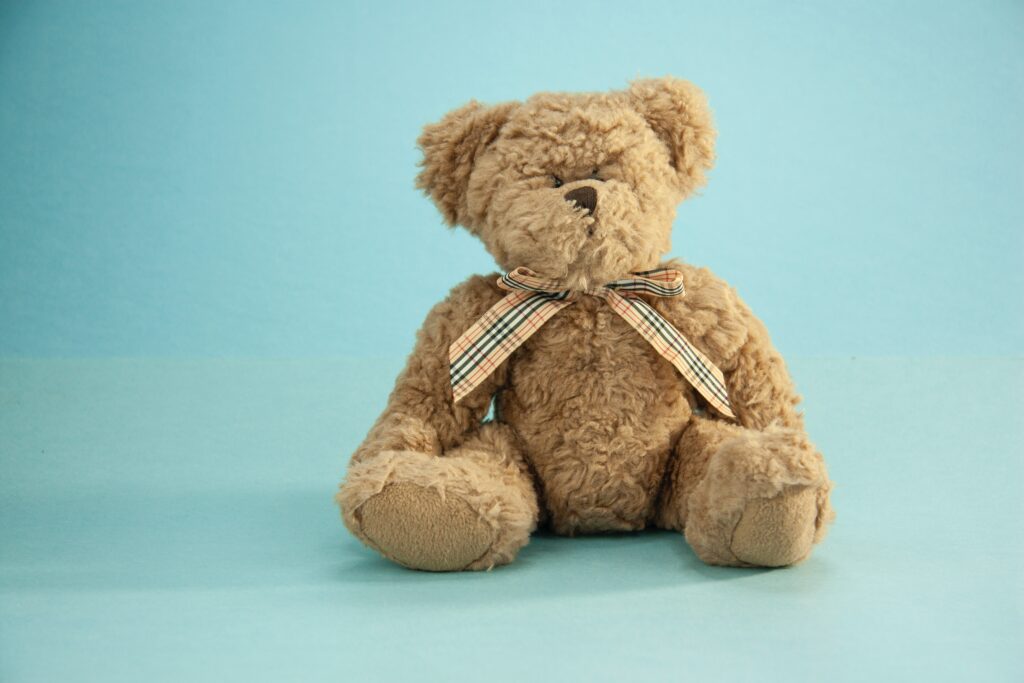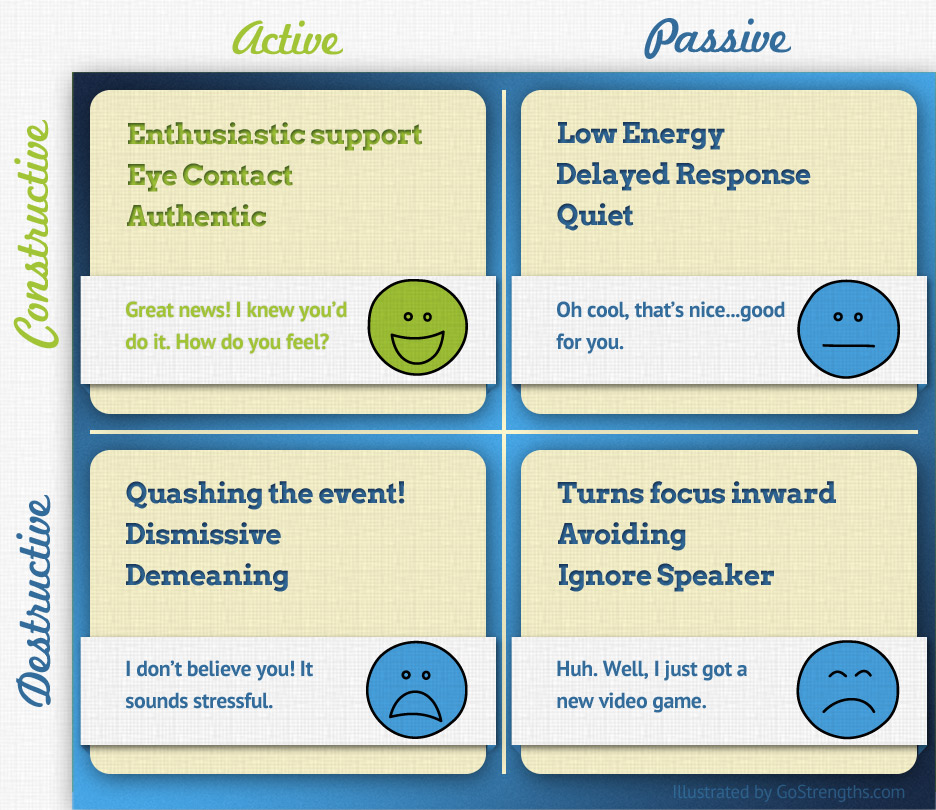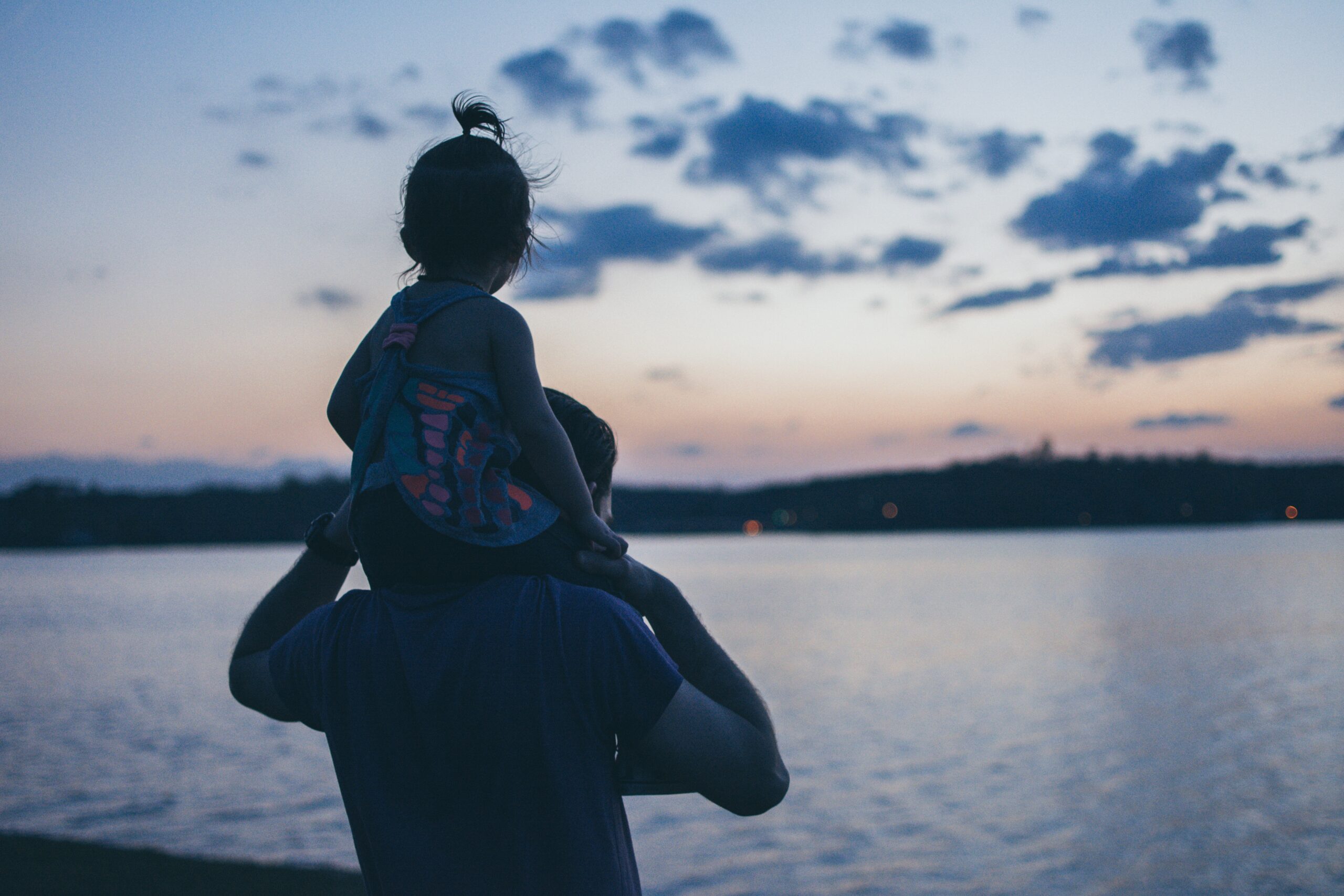Ever wonder why some conversations leave you feeling uplifted, while others seem to drain your energy? The secret often lies in how we respond to each other. Enter the game-changing concept of active constructive responding — a communication style that can turn ordinary chats into meaningful connections. Whether it’s with your kids, your partner, or your colleagues, mastering this technique can be your ticket to more fulfilling relationships and a richer emotional life.
Here’s a not-so-fun fact about me that I don’t often share: I don’t generally like kids. I find them to be a little annoying, and I don’t really relate to them. They talk about cartoons and other subjects that I find, well, nonsensical. Younger children, like infants and toddlers, are particularly challenging for me.
I recall a time in my early twenties when two friends of mine, Nathan and Tina, had just had a child. A few days later, I saw them in church, and Tina was allowing folks to hold their newborn. People were gushing with joy, filling the room with goo-goos and ga-gas, and other sweet baby talk. I stood there smiling, truly joyful myself. I believe that life is something beautiful.
But then something unexpected happened. Tina offered me her child to hold. As politely as I could, I declined. I thanked her for the offer, assuring her it was okay. I didn’t need to hold the baby. But she persisted. She really, really wanted me to hold her baby, and I felt so uncomfortable.
Some people love spending time with small children, and some don’t. Whichever side of that line you stand on, it’s okay. There’s nothing wrong with that.
Over the years, my wife and I have had our own children. While I love them more than anything, and they’re the exception to my rule, I haven’t always been the greatest father in one specific way. I discovered recently, while learning about different communication styles, that my inability to relate to young children affects how I speak to, pay attention to, and respond to them.
My oldest, Emma, is now a teenager. She and I dive into deep, soul-connecting conversations about the meaning of life. I could spend all my time talking with her and exploring the world together. I no longer have this aversion to children with her.
But then my youngest, Clara, will come in, wanting that same attention from Daddy. She’ll start telling me something, maybe something she thinks is funny, and without realizing it, I find myself not giving her the same level of attention. For instance, I might be reading an article on my laptop, responding with half-hearted comments like, “Oh, that’s really great,” even though I haven’t fully heard what she said.
In many instances, this likely left Clara feeling less than excited. She may have felt disappointed by the lack of heartfelt responses she got from me. My reactions will affect her attachment to her mother and me. According to attachment theory, this could have lifelong consequences for her.

Attachment Theory
Attachment theory is a way to understand how people, especially children, form close bonds with others. Do you remember having a favorite blanket or stuffed animal when you were little? It made you feel safe, calm, and cozy. Attachment theory dives deeper into this feeling, unraveling the emotional connection between a child and their caregiver, such as a parent or guardian.
Picture a child standing on the edge of a playground, ready to explore. The theory emphasizes that children need a “safe base,” a reliable figure they can trust and feel secure with. When kids know they can always run back to someone who will be there for them, they’re free to explore the world with bravery and confidence.
But what if that safe base isn’t so secure? What if the dependable hands they’re used to aren’t always there? That’s when different things can happen, and these connections can shape a child’s feelings and behavior as they grow. Let’s break this down and explore how:
- Secure Attachment: Think of this like having a warm hug or a loving smile waiting for you, no matter what. When a child knows their caregiver is dependable and responsive, they grow up feeling more confident and capable of handling emotions and relationships. It’s a foundation that makes them feel, “I am loved, so I can love others.”
- Avoidant Attachment: Imagine reaching for that favorite stuffed animal and finding it’s always just out of reach. Some children learn to pull back from people because they’ve been met with rejection or neglect. They might seem strong and independent, but underneath, they may struggle to open their hearts to others. It’s like a wall around their feelings, keeping them safe but also alone.
- Anxious Attachment: This is like clinging to that stuffed animal tightly, terrified to let it go. Some children become very clingy and fearful, constantly craving reassurance and attention. This attachment style happens when a caregiver is unpredictably loving, sometimes there and sometimes not. It leaves a child feeling, “Will you still love me if…?”
- Disorganized Attachment: Picture that sometimes the stuffed animal is soft and comforting, and at other times, it’s scratchy and unsettling. Children with this attachment style have faced confusion or even fear from inconsistent or chaotic treatment. Their reactions might seem confusing, reflecting the unpredictability they’ve known. It’s a way of saying, “I don’t know what to expect from you.”
In the grand tapestry of life, these attachment styles can weave patterns that affect friendships, romantic relationships, trust, and even self-worth.
The beauty of understanding attachment theory is how it sings a song about the power of love, understanding, and connection. Like a melody that stays with you long after the music has stopped, the bond between a child and caregiver can shape their entire life. It whispers a gentle reminder to each of us that being present for someone, truly seeing them, and being their “safe base,” can write a story of love and trust that lasts a lifetime. It tells us that our connections aren’t just moments; they’re the music that plays through all our days, making each one a little brighter and each relationship a bit warmer.
I deeply desire for my children to experience rock-solid attachments, but with my previous passive, uninterested responses, I would certainly have run the risk of her developing one of the other three attachment styles. And as you’ve seen, this could affect her for the rest of her life.

Active Constructive Responding
Imagine Clara, my youngest daughter, shares some exciting news with me. How I respond can make her feel on top of the world or maybe a little down. These four styles of responding are like tools I can use to handle that conversation. Let’s explore them:
Active Constructive Responding: The Joy Multiplier. Picture me high-fiving Clara and eagerly asking her all about her exciting news. My genuine excitement, curiosity, and the way we dance around and celebrate her achievement all come together. It’s more than a reaction; it’s a way of embracing her joy and making it our shared experience. Active constructive responding is an encouraging and warm response that makes Clara, or anyone we care about, feel valued, understood, and truly seen.
Active Destructive Responding: The Joy Killer. Now, imagine me leaning in with a concerned look, saying, “Are you sure about that? It sounds risky!” By focusing on the negatives or even criticizing her decision, it feels like I’m throwing a bucket of cold water on her excitement. This response can leave her, or anyone sharing their joy, feeling discouraged, misunderstood, and unheard.
If it’s your child, friend, or a loved one, and you’re truly concerned, you might feel a pull to react this way. Don’t let worry lead you down this path! Take a deep breath and stay focused on the joy first. Respond with genuine support and enthusiasm. Nurture that connection and celebrate with them. Later on, when the moment is right, you can patiently and tactfully share your concerns. By then, your words will be wrapped in understanding and love, and they will be better received.
Passive Constructive: The Conversation Killer. Imagine me smiling quickly at Clara and saying, “That’s nice,” but then moving on as if her news was just a passing thought. Though I might feel happy for her, my lack of visible enthusiasm can say something else entirely. It’s a polite response on the surface, but it might make her feel like I don’t really care all that much about what means so much to her.
This reaction often sneaks in when we’re distracted or disinterested in the topic someone is sharing with us. But let’s remember, it’s not about the topic; it’s about the person and our connection with them. It’s about seeing their joy and reflecting it back. So be intentional. Put aside your distractions and focus wholeheartedly on them. Your presence can turn a fleeting moment into a lasting memory.
Passive Destructive Responding: The Conversation Hijacker. Now, picture me hearing Clara’s good news and then immediately saying, “Cool, but wait till you hear what happened to me today!” It’s like turning away from her joy and shifting the spotlight squarely onto myself. It’s dismissive and can make her feel like her news, her feelings, don’t matter to me.
We all have our stories to tell, and we all want to be heard. But when someone is sharing their good news, that’s not our cue to take the stage. This is our chance to live in their moment, to rev up our empathy, understanding, and compassion, and to let that other person shine. It’s our opportunity to say, without words, “I’m here for you, and what matters to you matters to me.” It’s a way to build a bridge from one heart to another, a bridge that strengthens our bonds and enriches our shared journey.

Active Constructive Responding: Enrich Your Relationships
These different styles can shape our relationships in big and small ways. When we respond with warmth and interest (Active Constructive Responding), we’re building a strong bridge of connection with others. When we’re dismissive or critical (Passive or Active Destructive Responding), it’s like we’re putting cracks in that bridge.
The way we respond to others, whether with joy or indifference, builds or weakens our connections. Let’s remember to be present and intentional in our conversations. Think about how you’d feel if you were on the receiving end of these responses. When we truly see people and share in their joys or sorrows, we’re not just making conversation; we’re saying, “I’m here with you, and I care about what happens to you.” That’s a gift we can give each other, and it can make a world of difference.
Not that it’s necessary, but let me just inject a quick aside. I’d like to think that I’m not a horrible father. I’m being a bit harsh on myself here because I’ve learned that I grow most effectively when I allow myself to be fully vulnerable, open to self-reflection and dedicated to personal growth.
I’m now incredibly intentional about the way that I respond to her. We’re currently on vacation in a condo at the beach over a four day weekend. Yesterday afternoon, she came in interrupting me as I was sitting in the living room. This was the ideal conditions for me to provide her a passive response. I was relaxing and not necessarily interested in those trivial things. But I know better now.
She told me that her balcony had a table on it and that meant we could eat outside. As she shared her news with me, I sat up and leaned forward fully engaging. I playfully challenged her news telling her that’s not possible. This inspired her persistence. So I got up from the couch and followed her as she led me to her room. Once there I told her how awesome her discovery was and asked her follow up questions about it. I brought every bit of myself into that conversation and the connection was totally worth it.
The Thrill of Connection
Martin Seligman, often referred to as the father of Positive Psychology, teamed up with other researchers from the University of Pennsylvania. Together, they lent a helping hand to the United States Army. Their goal? Teaching soldiers resilience skills to help them forge strong bonds at home and stay sturdy despite the harsh realities of the battlefield. The class that resulted from this collaboration is called Master Resilience Trainer and this is where I learned this skill, among others.
Let me share a story from Professor Seligman’s book, The Hope Circuit, that resonates with my own journey. He writes, “One morning I came in very early to the Sheraton and sat down to breakfast. A master sergeant whom I had met the day before, when we taught active constructive responding to good events, joined me.
“‘I Couldn’t wait to tell you that something really cool happened last night after class, Sir,’ he said, barely restraining himself. ‘I called home, and my son answered. He was so excited. He hit a home run in Little League and won the game. We chatted for about five minutes, and then he asked, ‘Dad, is this really you?””
Can you imagine the thrill in that child’s voice? The disbelief that his father was truly engaged, present, and celebrating with him?
Pause for a moment and think about the people in your life who you care about. Picture their faces, hear their voices. Don’t you want to share that deeper, more-meaningful connection with them? The connection that lets them know you’re not only there but really present with them?
I’ve talked about our children as an example, but the truth is, this principle extends beyond the family home. It reaches into areas you might not even realize. Think about it; this is a tool you can wield as a leader or a member of a team in your workplace. You can tap into this way of responding with your romantic partner, or even with your close friends.
I’m challenging you here, right now: Give it a try. I dare you. You might just find that the way you respond to someone’s joy or pain, their triumphs or struggles, can turn an ordinary conversation into a bridge leading to something deeper, something more meaningful. It’s like reaching out your hand and saying, “I’m right here with you, and I care about what happens to you.” That connection, that bridge between two souls, can truly make a world of difference. It can change a day, mend a heart, and inspire a life.
So don’t just stand on the sidelines. Step into the arena of empathy, compassion, and connection. Use this gift that’s right there within your reach, because that’s the stuff that real life is made of. That’s how we create bonds that last, memories that inspire, and relationships that enrich every part of our journey.

